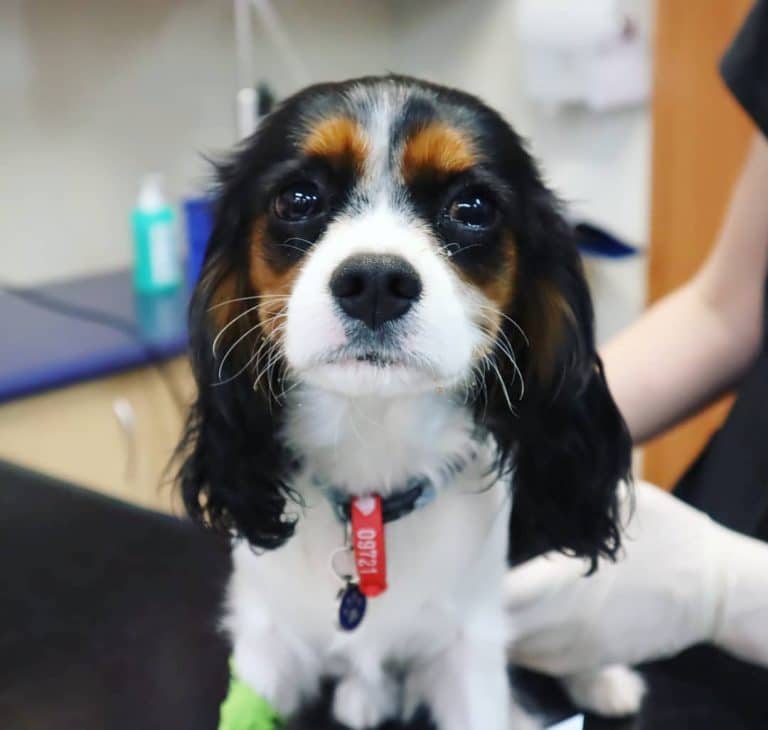Heat Stroke In Dogs: A Guide To Symptoms And Treatment
Heat stroke is a life-threatening illness
Heat stroke is a serious, sometimes fatal illness affecting every pet. When temperatures rise during the summer months, so do cases of heat stroke in dogs and cats. Unfortunately, many pet owners are unaware of the fact their pets can overheat to the point where it becomes life-threatening and treatment is ineffective.
This guide details the signs and symptoms of heat stroke in dogs and cats, how it is treated and prevention tips.
What you’ll learn
- What is heat stroke?
- Are heat stroke, heat stress, and heat exhaustion the same thing?
- What are the signs and symptoms of heat stroke in dogs and cats?
- Why does heat stroke occur?
- Can dogs die from heat stroke?
- What can I do to treat heat stroke in my dog and cat?
- How will my vet treat heat stroke?
- What are some practical ways to prevent heat stroke in dogs and cats?
What is heat stroke?
Heat stroke, although more prevalent during the summer months, can occur at any time of the year. It can happen quickly and without notice.
Dogs and cats are affected by heat in the same way as us humans are. We regulate our body temperature through the sweat glands found all over our bodies. Dogs and cats, on the other hand, only have a few sweat glands located around their noses and paws. Our pets cool themselves mainly by panting. The sweat glands in their paw pads and noses also aid in heat dispersion, but only very minimally.
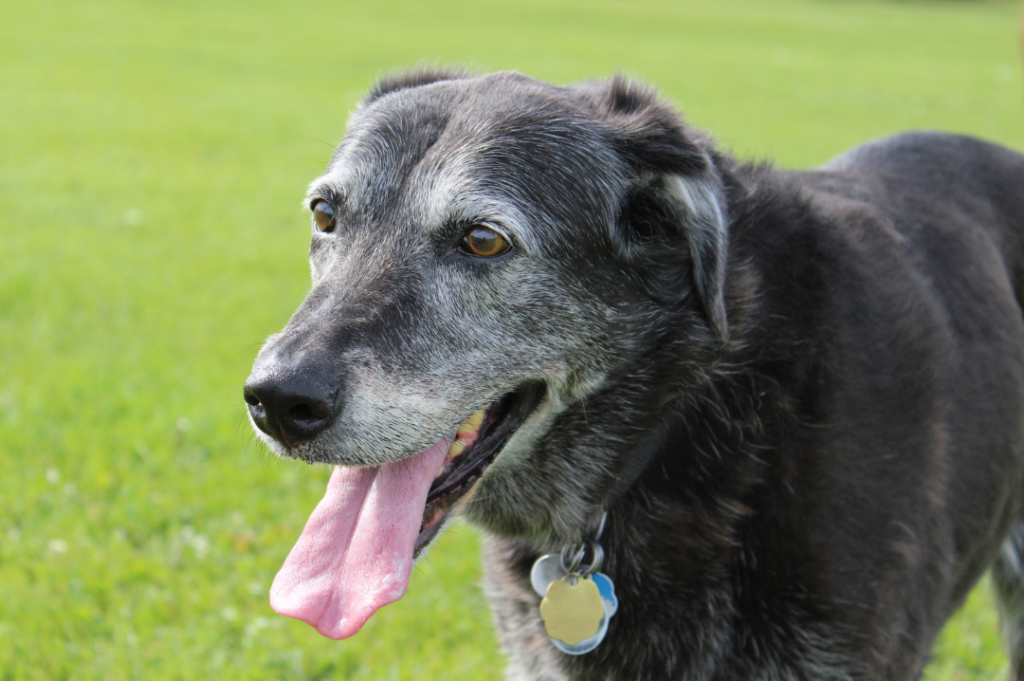
In order to cool their body temperature dogs pant
When our pets can’t cool themselves by panting, this is when hyperthermia and other heat-related illnesses can occur. Hyperthermia is when the body’s core temperature rises above 39 degrees Celsius (its normal range).
Are heat stroke, heat stress, and heat exhaustion the same thing?
There are three different types of hyperthermia. While many people confuse these terms, there are distinctions between each one in regards to their severity.
Heat stress is linked to an increase in thirst and panting. A pet suffering from this condition is mentally aware and can usually walk around unaided.
Heat exhaustion is a more serious form of heat stress. It’s linked with a large increase in thirst, weakness, and heavy panting. A pet with heat exhaustion may be mentally aware but is physically unable to react, may not be able to move around, and may collapse.
Heat stroke is the most serious form of hyperthermia. It occurs when a pet’s temperature reaches 41.1 degrees Celsius or higher. When the body’s temperature rises above this level, neurological, and organ dysfunction and failure develop. Once their temperature reaches 43 degrees Celsius, it destroys the proteins making up the building blocks of all cells in the body. Although there is no precise point at which these systems fail, higher temperatures and longer periods of heat exposure can lead to more organ dysfunction, as well as the potential for death.
Heat stroke’s effects are devastating, and treatment is required promptly in all circumstances, even when heat stroke is only suspected.
What are the signs and symptoms of heat stroke in dogs and cats?
There are many signs and symptoms of heat stroke in dogs and cats to be on the lookout for. But be aware, signs and symptoms will quickly become increasingly severe.
Early signs of heat stroke include:
- High body temperature
- Restlessness or agitation
- Excessive panting or difficulty breathing
- Drooling, often very thick saliva
- Change in gum colour (dark red, pale, purple, or blue)
As the condition worsens, signs and symptoms progress to include:
- Vomiting or diarrhoea (possibly with blood)
- Increased heart rate
- Lethargy or collapse
- Dizziness – are they struggling to walk in a straight line?
- Signs of confusion, delirium
- Muscle tremors
- Seizures
- Unconsciousness
Cats can also develop heat stroke, although it is less common. The signs and symptoms of heat stroke in cats are similar to those seen in dogs. However, there are a few different signs only cats exhibit.
Why does heat stroke occur?
Heat stroke occurs as a consequence of a variety of situations and factors. So how do dogs develop heat stroke? Factors linked to a dog’s environment play a significant role, but it’s important to know certain breeds or previous medical issues can also increase the risk for some pets. These factors can include:
High temperatures
- High humidity
- Lack of adequate airflow/ventilation
- No access to or inadequate shade
- No access to or inadequate drinking water
- Excessive exercise
- Pets who are not used to hot weather. Dogs can take up to 60 days to acclimate to significant changes in temperature.
- Pets left in closed homes or garages with no air conditioning
- Pets left in cars. Even on mild days or with the window down, temperatures can rise quickly.
Are some pets more susceptible to heat stroke?
While heat stroke affects all pets, certain breeds are more susceptible. These animals at a higher risk of heat stroke are:
- Small animals, such as birds, guinea pigs, rats and mice, rabbits, and ferrets. These animals are more susceptible as they are frequently confined to cages or hutches and are unable to migrate to areas with greater temperature variation. It is vital to relocate hatches and cages into cool, shaded, and well-ventilated locations with plenty of drinking water during hot weather. draping cages with wet towels, as well as providing icepacks or frozen water bottles for them to lean against will help to keep their body temperature cool.
- Extremes in ages (young and old)
- Thick or long coats retain the heat
- Overweight and obese pets
- Large breed dogs
- Extremely active, or working and hunting dogs, such as shepherds and retrievers
Brachycephalic breeds like French bulldogs are predisposed to heat stroke
Brachycephalic dogs, also known as short-nosed and flat-faced animals, are among the breeds most affected by this condition. Their smaller and narrower nostrils, long soft palate, and underdeveloped and smaller airways work in combination to obstruct effective airflow making it difficult for them to cool down. these breeds include pugs, English bulldogs, French bulldogs, Pekingese, and Persian and Himalayan cats. Brachycephalic dogs are more than 146% more likely to suffer from heat stroke than any other dog breed.
- Dogs who have a respiratory disease or breathing problems, such as laryngeal (vocal cord) paralysis, or a collapsing trachea
- Pets who have heart problems/cardiovascular disease
- Dogs with a neurological disease
- Dehydration
Can dogs die from heat stroke?
Although there is no precise time for how long it takes a dog to succumb to heat stroke, death can occur in as little as an hour. This is especially true of dogs who are susceptible to heat stroke. However, there have been occasions when a dog has perishe din as little as 15 minutes after displaying early signs of heat stroke.
Heat stroke is a life-threatening condition, resulting in multiple organ failures, including the heart, lungs, kidneys, clotting system, gastrointestinal tract, and brain. For every affected organ, prognosis decreases by 25%. If left untreated, recovery from heat stroke is nearly impossible. If heat stroke is detected and treated promptly, some dogs can recover fully. Others may have permanent organ damage which will require lifelong treatment.
What can I do to treat heat stroke in my dog and cat?
It is critical to remember heat stroke is a very serious, potentially fatal illness demanding immediate treatment to increase the chance of survival. If you suspect your pet has heat stroke follow the below steps and visit a veterinarian immediately:
- Remove your pet from the hot environment
- Lower your pet’s body temperature by wetting them down with a hose or bucket. Be sure to keep any water away from their face. A fan blowing over wet skin will aid in evaporative cooling. Don’t wrap a wet towel around them as it’ll trap any heat trying to escape.
- Don’t put your pet in ice baths as this can cool them too quickly, resulting in their blood vessels constricting and lowering their cooling ability
- Wetting down the areas around your pet may also assist in lowering the ambient temperature
- Offer water
- Even if your pet appears to be recovering or you only suspect they have heat stroke, it is critical to visit a veterinarian as soon as possible
How will my vet treat heat stroke?
When you visit your local veterinarian or an animal emergency hospital, the vet/s will evaluate the severity of your pet’s heat stroke and then begin immediate treatment as needed.
Heat stroke treatment can be complex and challenging and may require extended hospitalisation. The following are some of the treatments used:
- Emergency cooling, especially if your pet’s body temperature is still high
- Intravenous fluids to treat dehydration, shock and to cool the body down internally
- Oxygen therapy
- Anaesthesia and airway intubation for pets that are having breathing difficulties or are unconscious
- Gastric protectants and anti nausea medication in cases of vomiting and diarrhoea (as the gut may slough and start to die)
- Antibiotics to prevent secondary sepsis (blood poisoning)
- Pain relief
- Cardiac medications if required
- Blood tests to assess the severity of dehydration, to test for clotting, to assess organ function, and to monitor response to treatment
- Blood or plasma transfusion for those with clotting problems
- Ongoing monitoring and treatment usually in the intensive care unit
What are some practical ways to prevent heat stroke in dogs and cats?
The good news is heat stroke is preventable. As well as knowing the signs and symptoms in case your pet ever develops the condition, there are many other actions you can take. These include:
Dog’s paw pads are extremely sensitive to hot surfaces and can burn easily
Never leave pets unattended in parked cars
- Plan car trips – keep the car cool, ensure frequent stops and water is available
- Avoid exercise during the hottest times of the day
- Ensure there is plenty of cool water and shade available, both with easy access
- Don’t leave pet sinside hot, closed homes or garages
- Avoid walking pets on hot sand, concrete, bitumen, or any other surfaces where heat is reflected
Tips to keep your dog cool
While we keep cool with air conditioning, icy beverages and dips in swimming pools, we also need to think about our pets’ comfort. Here are some helpful hints on how to keep dogs cool in the heat:
Ute trays can become extremely hot in the sun. Should your dog travel on the back of a ute, cover the tray with a suitable material to provide shading to prevent them from burning their paws and other parts of their body.
- Pets with white non-pigmented skin and a white coat are particularly susceptible to sunburn. If you have a pet with a fair complexion, animal-specific sunscreen and zinc are must-haves for protection against the sun’s rays.
- A cooling mat or even a cool ceramic tile or baking tray cooled from the fridge or freezer for them to lie on works a treat
- Give frozen treats like doggy ice blocks
- Fill extra bowls of water in case one is knocked over
- Place ice in water bowls to help keep them cool
- Let your pet play in paddling pools. Place a clamshell or inflatable pool outside for your dog to wade in to keep cool.
- Get creative with exercise by creating cool games, and water play Iike homemade water sprinklers)
- Be aware muzzles can restrict a dog’s ability to pant which is necessary for them to cool themselves
If you believe your pet has heat stroke, visit Perth Vet Emergency or your local veterinarian immediately.

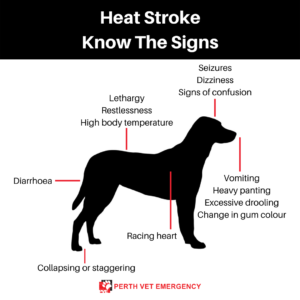
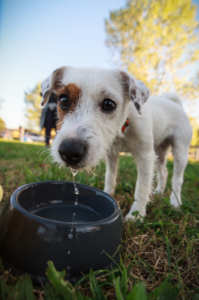 High temperatures
High temperatures


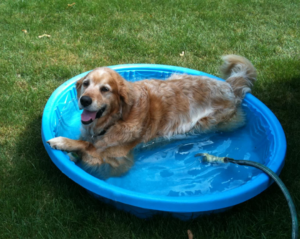 Ute trays can become extremely hot in the sun. Should your dog travel on the back of a ute, cover the tray with a suitable material to provide shading to prevent them from burning their paws and other parts of their body.
Ute trays can become extremely hot in the sun. Should your dog travel on the back of a ute, cover the tray with a suitable material to provide shading to prevent them from burning their paws and other parts of their body.

